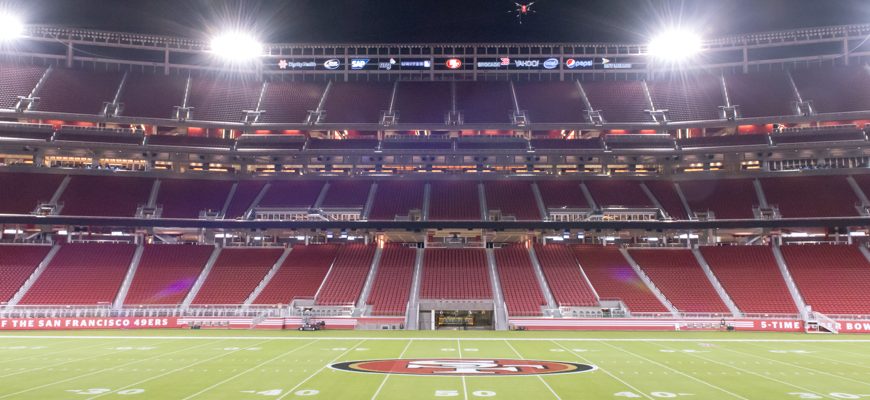Last week the 49ers celebrated Levi’s Stadium’s first concert, Coldplay, 1001 days after the last concert in 2019 and 10 years to the month after Mayor Lisa Gillmor and 49ers co-owner Jed York drove the first shovels into the Santa Clara ground that would become Levi’s Stadium. If that wasn’t auspicious enough, May was also the anniversary of the first concert in Levi’s Stadium: Kenny Chesney in 2015.
Gillmor wasn’t there, nor was District 1 Council Member Kathy Watanabe, to celebrate the post-COVID return of the stadium they had campaigned so hard to bring to Santa Clara.
Instead, Santa Clara Council Members Anthony Becker and Karen Hardy were there to celebrate a new start for stadium concerts at Levi’s after two years of COVID shutdown and three years of a Sunday through Thursday 10 p.m. curfew that sent concert promoters to other Bay Area venues. The curfew lost the City an estimated $5 million a year as big name performers chose other locations.
With nearly every seat at Levi’s sold out, the event will likely put $400,000 to $500,000 into the City’s general fund, based on historical numbers for Levi’s Stadium concerts. On top of that, Santa Clara will benefit from hotel tax revenue — four sold-out hotels (about 2,000 rooms) on weekend nights, which would normally be low bookings — and sales tax from food, beverage and merchandise purchases.
The rest of the season looks equally favorable with five more stadium concerts already booked — one show, Elton John, booking a second, weeknight, date.
“I’m thrilled that we’re open for business,” said Council Member Hardy. “There’s pent-up demand for events. If we wouldn’t have given the curfew waiver, we wouldn’t have gotten this event. The reality is, we would not have gotten these other events.”
Technically, the curfew wasn’t “lifted” — it was “waived.” That was the status quo before Gillmor and her allies on the 2017 Council imposed no-exceptions enforcement.
Hardy initially opposed building the stadium when it was first proposed in 2008. She was to the stadium opposition what Gillmor was to the stadium boosters. But as a council member today, she said, “My job is to make this [stadium] profitable for the City. It was up to them [the 49ers] to show us the case [for the curfew waiver].”
Not everyone was happy about the concert’s success, though. Sunday evening Council Member Watanabe was on social media saying that she had heard complaints about parking, claiming that Santa Clara police weren’t enforcing the stadium event traffic and parking rules and blaming the 49ers.
However, the police received only two noise complaints the night of the concert, and none about neighborhood traffic or parking, according to City records.
Stadium Story Began in the 1970s
It’s been 16 years since the idea of a 49ers stadium in Santa Clara saw daylight. But what brought Levi’s Stadium to the City in the first place?
There are many pieces to the story from then-Parks and Rec Commissioner Kevin Moore’s 2008 letter to the 49ers suggesting Santa Clara for a new stadium, to former Mayor Eddie Souza’s far-sighted decision to invite the 49ers to build their training camp here in 1987, to Gillmor’s indefatigable campaign that was financed with $3.6 million of 49ers money and put Jed York in Santa Clara living rooms for coffee chats.
But long before any of those things happened, Santa Clara’s legendary Mayor and City Manager team of Gary Gillmor (father of the current Mayor Gillmor) and Don Von Raesfeld put the infrastructure in place in the 1970s that would make Santa Clara’s Northside a contender.
Gary Gillmor calls that infrastructure the City’s “holy trinity of success,” city-owned land and electricity, and strategic use of redevelopment funding.
Gary Gillmor and Von Raesfeld got the freeway interchanges by going to Sacramento to persuade then Gov. Ronald Reagan to support the projects, and ultimately lending CalTrans the money to build the interchanges that make Levi’s Stadium easy to get to. CalTrain was already there, with the VTA light rail and ACE train and 40,000 parking spots in industrial lots to come.
Santa Clara’s city-owned electric company provided reliable power at a reliably low price thanks to Von Raesfeld’s nearly quarter-century strategy to make Santa Clara energy self-sufficient and Gary Gillmor’s energetic support.
The final part of this trinity was the foresighted use of the Santa Clara redevelopment agency (RDA) to build infrastructure on the Northside that reduced development costs for builders.
“Urban renewal [redevelopment] let you go in and prepare the site,” Von Raesfeld told The Weekly in 2012. “You borrow the money to build and the businesses that move there will raise the property values. The increased value pays for the infrastructure bonds.”
For more, check out:
Santa Clara the Can Do City that Could Build a Stadium (here)
The Right Stuff Santa Clara Infrastructure Foundation for Today’s Stadium (here)







I am for the city making money. As long as the noise level does not cause a problem with the residents next door. I am also looking forward to the Related Project across the street from Levi’s Stadium. I am tired of the delays for the Related Ground Breaking. That funded Covid Plandemic did a real number on our Economy.
Hi, Ed. I have friends and relatives living nearby Levi’s Stadium. They’ve often informed me that the noises from the overhead airplanes are ten times louder than the noises they’re hearing from the stadium. Not only that, but the overhead airplane’s noises are 365 days a year, and dozens and dozens of times each and every single day.